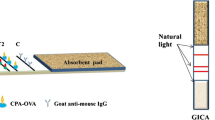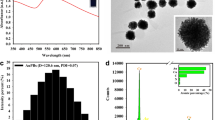Abstract
Total aflatoxins (AFTs) are an important safety indicator for botanical materials, but at present, rapid detection technology for AFTs is seldom reported. In this study, the monoclonal antibody with similar reactivity to total aflatoxins was produced, and the quantum dot–based lateral flow immunoassay (QD-LFIA) coupled with a portable device was developed to rapidly determine AFT residues in botanical materials. The half maximal inhibitory concentrations (IC50) of the QD-LFIA for AFB1, AFB2, AFG1, AFG2, AFM1, and AFM2 were 10.57, 12.64, 11.34, 12.67, 10.13, and 12.75 μg kg−1, respectively, which show high reaction consistency to total aflatoxins. For different botanical materials, the sample was simply extracted with methanol-water and diluted with PBS, and the sample solution was directly loaded onto the QD-LFIA strip for determination. To overcome interference from the matrix effects, specific standard curves were established for each kind of botanical material. The detection limit of AFTs in 6 different botanical materials was 0.95~2.03 μg kg−1 with a linear range of 2~120 μg kg−1. The spiked recoveries of AFTs in botanical materials of different species and localities of growth were 75~105% with a coefficient of variation below 15%. The test results of the actual samples are consistent with the Chinese national standard test method. This study provides an easy-to-use method to rapidly determine AFTs in different botanical materials.

Graphical abstract




Similar content being viewed by others
References
Jaiswal Y, Liang Z, Zhao Z. Botanical drugs in Ayurveda and traditional Chinese medicine. J Ethnopharmacol. 2016;194:245–59. https://doi.org/10.1016/j.jep.2016.06.052.
Wild CP, Turner PC. The toxicology of aflatoxins as a basis for public health decisions. Mutagenesis. 2002;17(6):6. https://doi.org/10.1093/mutage/17.6.471.
Cullen JM, Ruebner BH, Hsieh LS, Hyde DM, Hsieh DP. Carcinogenicity of dietary aflatoxin M in male Fischer rats compared to aflatoxin B1. Cancer Res. 1987;47(7):1913–7.
Li P, Qi Z, Wen Z. Immunoassays for Aflatoxins. Trends Anal Chem. 2009;28(9):1115–26. https://doi.org/10.1016/j.trac.2009.07.003.
Uwaifo AO, Bababunmi EA. The reduced mutagenicity of aflatoxin B1 due to hydroxylation: observations on five Salmonella typhimurium tester strains. Cancer Lett. 1979;7(4):221–5. https://doi.org/10.1016/S0304-3835(79)80084-1.
Richard JL. Some major mycotoxins and their mycotoxicoses—an overview. Int J Food Microbiol. 2007;119(1–2):3–10. https://doi.org/10.1016/j.ijfoodmicro.2007.07.019.
Yang MH, Chen JM, Zhang XH. Immunoaffinity column clean-up and liquid chromatography with post-column derivatization for analysis of aflatoxins in traditional Chinese medicine. Chromatographia. 2005;62(9–10):499–504. https://doi.org/10.1365/s10337-005-0647-z.
Zheng H, Zheng Y, Luan L, Cai Z, Ren Y, Wu Y. An ultra-high-performance liquid chromatography-tandem mass spectrometry method for simultaneous determination of aflatoxins B1, B2, G1, G2, M1 and M2 in traditional Chinese medicines. Anal Chim Acta. 2010;664(2):165–71. https://doi.org/10.1016/j.aca.2010.02.009.
Liu S, Qiu F, Kong W, Wei J, Xiao X, Yang M. Development and validation of an accurate and rapid LC-ESI-MS/MS method for the simultaneous quantification of aflatoxin B 1 , B 2 , G 1 and G 2 in lotus seeds. Food Control. 2013;29(1):156–61. https://doi.org/10.1016/j.foodcont.2012.05.069.
Ma SC, Jin HY, Liu LN, Wang Y, Sun L. Risk control of exogenous harmful residues in traditional Chinese medicines. Chin Pharm J. 2015;50(2):99–103. https://doi.org/10.11669/cpj.2015.02.002.
Wei R, Yang X, Qiu F, Yang M, Qin J. Simultaneous determination of aflatoxin B1, B2, G1, G2 and ochratoxin A in Glycyrrhiza uralensis by HPLC-fLD after immunoaffinity column with online post-column photochemical derivatization. China J Chin Mater Med. 2011;36(17):2342. https://doi.org/10.1007/s10570-010-9464-0.
Chinese Pharmacopoeia. Vol.1. Beijing: China Medical Science Press; 2015.
European Pharmacopoeia European Directorate for the Quality of Medicines & HealthCare; 2010.
British Pharmacopoeia Vol. V. British Pharmacopoeia Commission; 2013. p. A318.
Jiong LI, Tang M, Wang HQ, Cao QW, Qiu HY, Zhu GL. Detection of four aflatoxins in Ganoderma lucidum spore powder by HPLC-MS/MS. J Chin Med Mater. 2017;40(09):2060–3. https://doi.org/10.13863/j.issn1001-4454.2017.09.014.
Xin W, Jia Y, Qi G, Nan L, Fan J, Xiong W, et al. Determination of aflatoxin and zeranol and its agalogs in milk by high performance liquid chromatography with immunoaffinity clean-up column. China Dairy Ind. 2014;042(6):38–40,54. https://doi.org/10.3969/j.issn.1001-2230.2014.06.010.
Wu G, Li H. Detection of aflatoxins in Chinese medicinal herbs by post-column derivatization and HPLC-FLD. China Pharm. 2016;25(18):64–7.
Jiang T, Liu Z, Zheng J, Min LI, Rong JI. Quantitative analysis of aflatoxins by ELISA. Chin J Food Hyg. 2006;(04):292–6. https://doi.org/10.13590/j.cjfh.2006.04.002.
Masinde LA, Sheng W, Xu X, Zhang Y, Yuan M, Kennedy IR, et al. Colloidal gold based immunochromatographic strip for the simple and sensitive determination of aflatoxin B1 and B2 in corn and rice. Microchim Acta. 2013;180(9–10):921–8. https://doi.org/10.1007/s00604-013-1008-5.
Ren M, Xu H, Huang X, Kuang M, Xiong Y, Xu H, et al. Immunochromatographic assay for ultrasensitive detection of aflatoxin B1 in maize by highly luminescent quantum dot beads. ACS Appl Mater Interfaces. 2014;6(16):14215–22. https://doi.org/10.1021/am503517s.
Jing LI, Wu LP, Qi Z, Xia DX, Wen Z, Wei ZZ. Investigation of time- resolved fluoro- immunochromatographic assay strip for quantitative determination of aflatoxin B_1 in oilseed meals. Chin J Oil Crop Sci. 2014;36(2):256–62. https://doi.org/10.7505/j.issn.1007-9084.2014.02.018.
Zhao Y, Liu X, Wang X, Sun C, Wang X, Zhang P, et al. Development and evaluation of an up-converting phosphor technology-based lateral flow assay for rapid and quantitative detection of aflatoxin B1 in crops. Talanta. 2016;161:297–303. https://doi.org/10.1016/j.talanta.2016.08.058.
Frigerio C, Ribeiro DSM, Rodrigues SSM, Abreu VLRG, Barbosa JOAC, Prior JOAV, et al. Application of quantum dots as analytical tools in automated chemical analysis: a review. Anal Chim Acta. 2012;735(none):9–22.
Duan H, Chen X, Xu W, Fu J, Xiong Y, Wang A. Quantum-dot submicrobead-based immunochromatographic assay for quantitative and sensitive detection of zearalenone. Talanta. 2015;132:126–31.
Zhou Y, Xiong S, Jiang H, Duan H, Xiong Y, Andrew W. Immunochromatographic assay for quantitative detection of ochratoxin A in maize by quantum dot beads. Chin J Anal Chem. 2015;42(12):1837–43. https://doi.org/10.11895/j.issn.0253-3820.150468.
Jieying L, Mao M, Feng W, Qiang L, Luyao W, Lan M. Amino-functionalized CdSe/ZnS quantum dot-based lateral flow immunoassay for sensitive detection of aflatoxin B1. Anal Methods. 2018;10. https://doi.org/10.1039/C8AY00608C-.
Hu S, Dou X, Zhang L, Xie Y, Yang S, Yang M. Rapid detection of aflatoxin B 1 in medicinal materials of radix and rhizome by gold immunochromatographic assay. Toxicon. 2018;150:144–50. https://doi.org/10.1016/j.toxicon.2018.05.015.
Woychik NA, Hinsdill RD, Chu FS. Production and characterization of monoclonal antibodies against aflatoxin M1. Appl Environ Microbiol. 1985;48(6):1096–9. https://doi.org/10.1128/AEM.48.6.1096-1099.1984.
Ung TDT, Tran TKC, Pham TN, Nguyen DN, Dinh DK, Nguyen QL. CdTe and CdSe quantum dots: synthesis, characterizations and applications in agriculture. Adv Nat Sci Nanosci Nanotechnol. 2012;3(4):043001. https://doi.org/10.1088/2043-6262/3/4/043001.
Liu J-M, Lin L-p, Wang X-X, Lin S-Q, Cai W-L, Zhang L-H, et al. Highly selective and sensitive detection of Cu2+ with lysine enhancing bovine serum albumin modified-carbon dots fluorescent probe. Analyst. 2012;137(11):2637–42. https://doi.org/10.1039/C2AN35130G(Paper)Analyst.
Delmulle BS, Saeger SD, Sibanda L, Barna-Vetro I. Development of an immunoassay-based lateral flow dipstick for the rapid detection of aflatoxin B1 in pig feed. J Agric Food Chem. 2005;53(9):3364–8. https://doi.org/10.1021/jf0404804.
GB 5009.22–2016. National food safety standard-Determination of aflatoxin B and G in foods. National standards of the People’s Republic of China.
Kim SH, Cha SH, Karyn B, Park SW, Kang HG. Production of group specific monoclonal antibody to aflatoxins and its application to enzyme-linked immunosorbent assay. Toxicol Res. 2011;27(2):125–31. https://doi.org/10.5487/TR.2011.27.2.125.
Li P, Li X, Zhang Q, Ding X, Zhang W, Li R et al., inventors; Hybridoma cell line 10G4 and monoclonal antibody produce thereby against sum of aflatoxins B1, B2, G1, and G2 patent WO2013155882. 2013-10-24.
Kuang H, Xu C, Zhang X, Xu L, Ma W, Liu L et al., inventors; A general anti-aflatoxin monoclonal antibody hybridoma cell line and its application patent CN104004717A. 2014 2014-05-21.
Chadseesuwan U, Sangdokmai A, Pimpitak U, Puthong S, Palaga T, Komolpis K. Production of a monoclonal antibody against aflatoxin M1 and its application for detection of aflatoxin M1 in fortified milk. J Food Drug Anal. 2016;24(4):780. https://doi.org/10.1016/j.jfda.2016.02.002.
Chung JD, Zabel C, Sinskey AJ, Stephanopoulos G. Extension of Sp2/0 hybridoma cell viability through interleukin- 6 supplementation. Biotechnol Bioeng. 1997;55(2). https://doi.org/10.1002/(SICI)1097-0290(19970720)55:2<439::AID-BIT21>3.0.CO;2-A.
Suiyan O, Zhaowei Z, Ting H, Peiwu L, Qi Z, Xiaomei C, et al. An on-site, ultra-sensitive, quantitative sensing method for the determination of total aflatoxin in peanut and rice based on quantum dot nanobeads strip. Toxins (Basel). 2017;9(4). https://doi.org/10.3390/toxins9040137.
Zhang D, Li P, Zhang Q, Zhang W. Ultrasensitive nanogold probe-based immunochromatographic assay for simultaneous detection of total aflatoxins in peanuts. Biosens Bioelectron. 2011;26(6):2877–82. https://doi.org/10.1016/j.bios.2010.11.031.
Shao Y, Duan H, Guo L, Leng Y, Lai W, Xiong Y. Quantum dot nanobead-based multiplexed immunochromatographic assay for simultaneous detection of aflatoxin B1 and zearalenone. Anal Chim Acta. 2018;1025:163–71. https://doi.org/10.1016/j.toxicon.2018.10.202.
Ning F, Lina F. The determination of aflatoxin B1 in traditional Chinese medicine by colloidal gold immunochromatography. Chin Med Mod Distance Educ China. 2020;18(11):109–11. https://doi.org/10.3969/j.issn.1672-2779.2020.11.045.
Funding
The work was supported by the National Key R&D Program of China (2018YFF0212503) and the Fundamental Research Funds for the Central Universities (FRF-AS-17-010).
Author information
Authors and Affiliations
Contributions
Y.W. and B.Y. did the experiment and wrote the manuscript; P.C. prepared the QD-LFIA card; T.Y. prepared the software and the hardware of the QD reader; and G.S. and Z.S. designed the experiment and revised the manuscript.
Corresponding authors
Ethics declarations
Conflict of interest
The authors declare that they have no conflict of interest.
Ethics approval
We observed all applicable international, national, and institutional guidelines and ethics of welfare of experimental animals for the care and use of animals. Identification code: SYXK(Shandong Province)2016 0008; date of approval: 7 March 2016; institutional review board: Shandong Department of Science and Technology; authorized unit: Shandong Lvdu Biotechnology Co., Ltd.
Additional information
Publisher’s note
Springer Nature remains neutral with regard to jurisdictional claims in published maps and institutional affiliations.
Supplementary information
ESM 1
(PDF 431 kb)
Rights and permissions
About this article
Cite this article
Wu, Y., Yu, B., Cui, P. et al. Development of a quantum dot–based lateral flow immunoassay with high reaction consistency to total aflatoxins in botanical materials. Anal Bioanal Chem 413, 1629–1637 (2021). https://doi.org/10.1007/s00216-020-03123-4
Received:
Revised:
Accepted:
Published:
Issue Date:
DOI: https://doi.org/10.1007/s00216-020-03123-4




